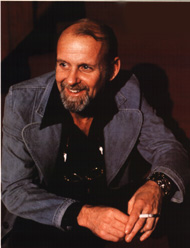Bob Fosse |
American choreographer.
After a spell in the US Navy, Fosse put in two years in acting school before heading out on the road in the chorus of Call Me Mister in 1948. Two years in the chorus brought him to Broadway in the revue Dance Me A Song. Then Hollywood beckoned. 'I had fantasies of becoming the next Fred Astaire,' admitted Fosse, years later. After small parts in three films, including Kiss Me, Kate (1953), Fosse realised he was going nowhere and headed back to Broadway. That was when he got his big break. Veteran director and playwright George Abbott took a chance on the young man for the choreography of The Pajama Game (1954). Fosse's ground-breaking staging of 'Steam Heat' was the talk of New York and the show became a huge hit. The number contained elements which were to become recognisable as Fosse's choreographic signature: small groups of dancers, drilled down to the lift of an eyebrow, executing steps which are sometimes disjointed, sometimes tortuously slow-motion - movement which seems to take the human body apart and make each piece work separately. Fosse was in demand. The following year he worked alongside Abbott again on Damn Yankees, an unlikely combination of the Faust myth and baseball, chiefly remembered for the seductive Gwen Verdon as the devil's sexiest demon, singing 'Whatever Lola wants, Lola gets'. From then on, Verdon was leading lady in almost all Fosse's shows, becoming the definitive Fosse dancer - all dazzling legs and double-jointed shoulders. After hits with New Girl In Town (1957) and Redhead (1959), one of Broadway's greatest partnerships got married in 1960. By now, Fosse was directing as well as choreographing his shows. He became one of those rare directors whose name is bigger than the star's. He staged block-busting hits one after each other, following Sweet Charity with Pippin (1972), Chicago (1975) and Dancin' (1978). Those four shows alone notched up over 5,000 performances between them, and their creator finished with a total of eight Tony Awards. Fosse also had a successful career in movies. His choreography for My Sister Eileen (1955), The Pajama Game (1957) and Damn Yankees (1958) was well received and, for Sweet Charity (1969), he became the first man since Busby Berkeley to be given absolute control over a production. The result was box office disaster and, for four years, no one in Hollywood wanted to know him. After a string of other directors had turned it down, Fosse took charge of the movie of Cabaret, in 1972. It was his greatest year. He won an Oscar for Cabaret, a Tony for the stage show Pippin and an Emmy Award for Liza Minnelli's TV special, Liza With A Z. It also gave him the chance to make a tribute to his friend, comedian Lenny Bruce, in the non-musical film Lenny, in 1974. But there was a price to be paid for such a relentless workload. In 1975, Fosse's chain-smoking caught up with him, when he suffered a heart-attack during work on Chicago. The show marked Gwen Verdon's come-back on Broadway but it also marked the end of their marriage. Fosse's two earlier marriages, to dancers Mary Arm Niles and Joan McCracken, had ended in divorce; now the strain was telling on Fosse and Verdon. They divorced that year, though their working partnership continued. Mirroring his autobiographical movie, All That Jazz (1979), Fosse himself died just moments before the curtain up on the triumphant revival of Sweet Charity. It could perhaps be argued that the latest hit revival of Kander and Ebb's Chicago, supervised by Ann Reinking - a Fosse protegée - is very much a tribute to the late, great Bob Fosse.
|
 The son of a vaudevillian, Bob Fosse was born into
the theatre. At 13 he was already touring with his own dance act,
called The Riff Brothers. At 15 he choreographed his first number
in a night-club, in which girls manipulated strategically-placed
ostrich feathers to Cole Porter's 'That Old Black Magic'. It was
the kind of sexual suggestiveness which would become a trademark
of Fosse's choreography.
The son of a vaudevillian, Bob Fosse was born into
the theatre. At 13 he was already touring with his own dance act,
called The Riff Brothers. At 15 he choreographed his first number
in a night-club, in which girls manipulated strategically-placed
ostrich feathers to Cole Porter's 'That Old Black Magic'. It was
the kind of sexual suggestiveness which would become a trademark
of Fosse's choreography.